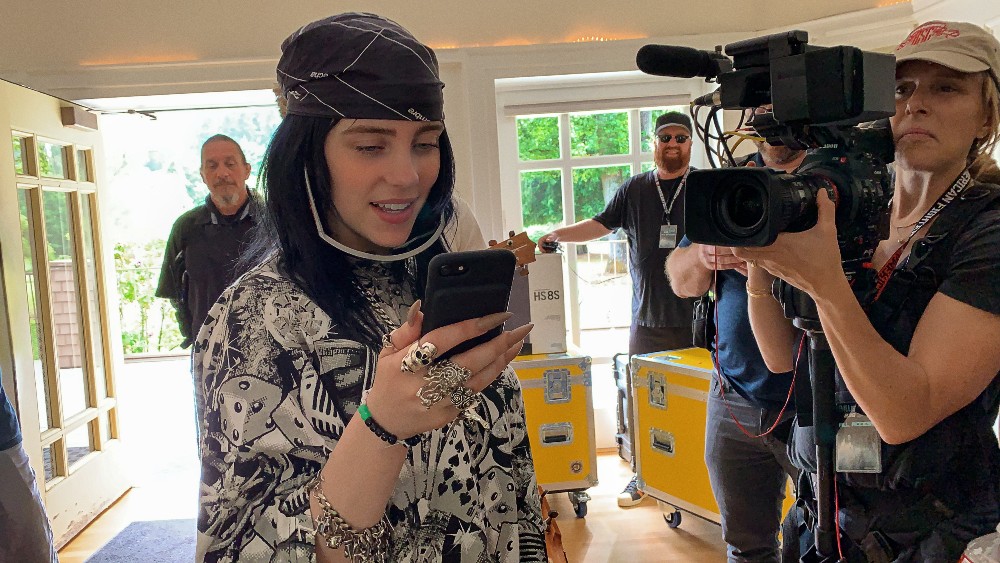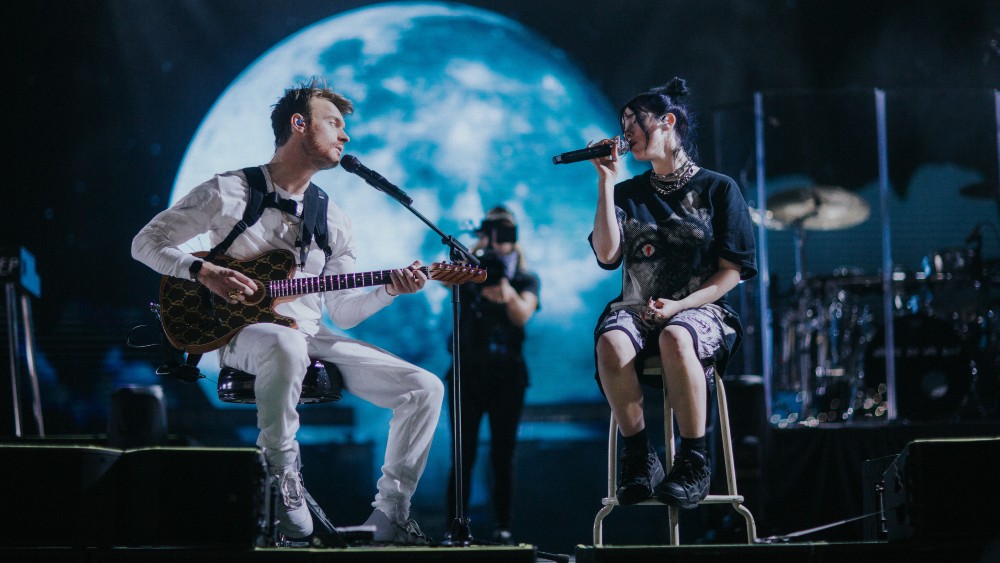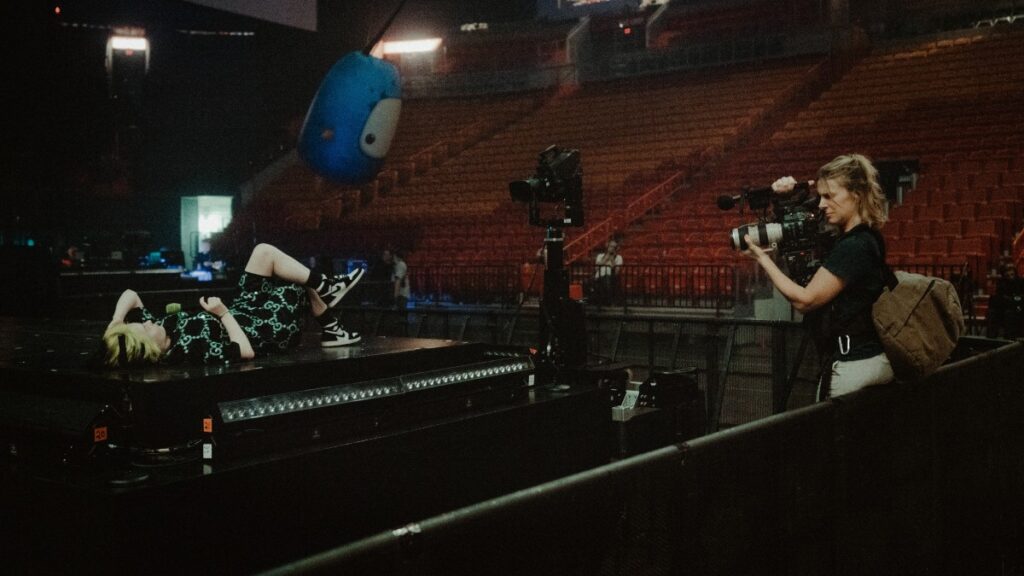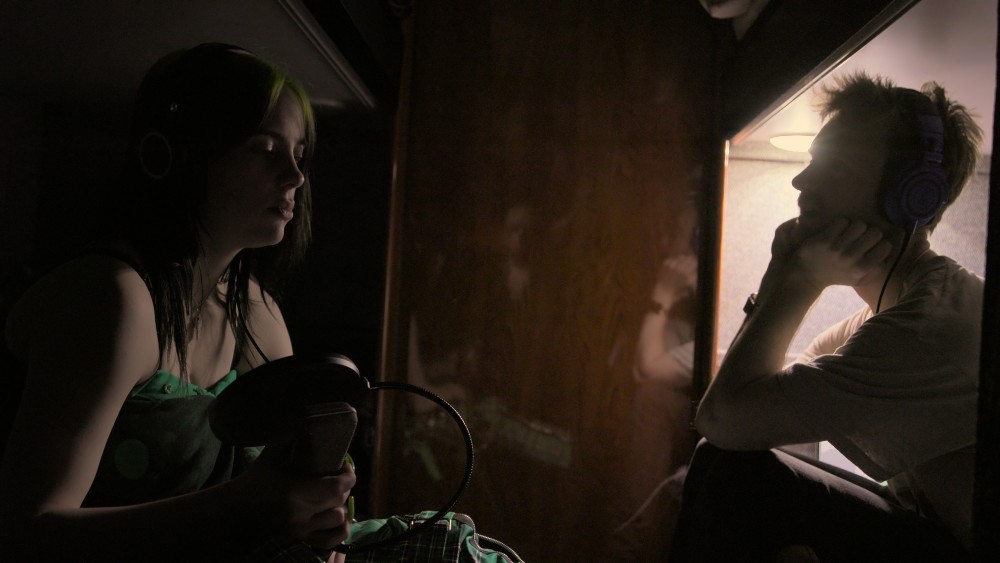
When singer Billie Eilish walked away from the 2020 Grammy Awards with six Grammys on January 26, 2020– including her debut album When We All Fall Asleep, Where Do We Go? winning Album of the Year, her song “Bad Guy” winning Record and Song of the Year, as well as Eilish winning for Best New Artist — it was the end of a meteoric rise into becoming one of pop’s top stars. Eillish would win her seventh Grammy earlier this month.
Capturing Eilish’s incredible journey was documentarian R.J. Cutler and his Cinematographer, Jenna Rosher, who had previously worked with Cutler but also was the DoP on many other esteemed docs, including the “American Masters” doc Norman Lear: Just Another Version of You, Amy Berg’s An Open Secret and Janis: Little Girl Blue, and Jesus Camp. Rosher has also directed four docs herself, including Let’s Spend the Night Together in 2010 and 2017’s The L.A. Riots: 25 Years Later.
The duo spent the majority of 2019 following Eilish around on the tour for her debut album, including a high-profile appearance at the annual Coachella Festival and more personal moments at home and backstage with brother Finneas.
The results are Billie Eilish: The World’s a Little Blurry, an incredible Apple Originals doc that debuted on Apple+ earlier this year after a short theatrical release.
Below the Line got on a Zoom call with Ms. Rosher for the following interview to talk about what was involved with the unprecedented they had to the teenage singer whose fame was exploding as their cameras rolled.
Below the Line: I liked the documentary a lot, and I’m not particularly a Billie Eilish fan. I just knew her stuff, because my friend’s 8-year-old son was obsessed with her music and would listen to her music constantly.
Jenna Rosher: I love it. She has a wide span … my mom is almost eighty – she’d kill me if she heard me say that – and she loves Billie, and my child– I have a seven-year-old — she loves Billie. I mean, she really appeals to a wide group.
BTL: You and R.J. Cutler have made an amazing movie, so how did you get started on this, I presume sometime in 2017 or 2018? How did R.J. approach you about it and what kind of time commitment did he say you’d need?
Rosher: R.J. started talking to me about it in 2018, and he said, “You know, there’s this project that’s come my way, and it’s about this artist. It’s literally the label saying it’s gonna blow up pretty big.” I was like, “I’ve heard that prediction before…” [chuckles] “Yeah, send me some links.” R.J. and I have worked together on other projects– I was one of the additional DPs on September Issue, and I’ve worked on a handful of projects with him. The doc community is relatively small at the end of the day. I’ve always obviously been a huge fan of R.J.’s work, and we’re also good friends.
He said, “I just think if this is a go, I feel like that we can make a really incredible film about this individual.” I started to see music videos of her. I watched the Vanity Fair article that was first done, and I was like, “Whoa. Who is Billie?” Right away, I was just completely blown away by her accessibility, her relatability, her vulnerability, all the abilities. I was sold.
It’s interesting, when you’re shooting docs, you tend to have to kind of straddle different projects, right? It’s not like a fiction series where you’re plunked down for four months, and you have a good job. Life happens and unfolds, and we’re not filming every week. From the very, very beginning, I was so intrigued by her and by her family and their involvement in her in her career and her relationship with their brother and their creative collaboration. I was like, “I want to be full time on this film. I’m just going to find a way to make it work” and and turned down other jobs. There we were at the beginning of 2019, off and running on the Billie Eilish film, officially. I was so intrigued by her and just knew, R.J.’s approach was like, “Watch Don’t Look Back again, watch Gimme Shelter again. Just get refreshed on the great verité music docs that we all know and love.” And I did, and I was like, “I get it.” We knew exactly what we were going to do.
BTL: Was there someone filming earlier stuff? I know this goes back to them actually writing songs for the record, which is pretty amazing to see them working on “Bad Guy,” completely oblivious to the fact that it would be this huge hit later.
Rosher: Well, a lot of that footage is Mom. Who knew? Mom would plant down GoPros, or she would just come in and ask them what they want for lunch, and then she would start filming them, a lot of that footage early. Very soon thereafter, we jump in and we start filming, but Mom is still always filming. That’s the great thing is like she’s made this personal archive of this journey, and there’s just so much documentation on Billie’s life, her childhood.
I think from the beginning, the approach was really to capture this moment in her life. Yes, there’s a fair amount of leading up. It’s not inundated with childhood home-grown archival footage. There’s a bit of it, but the journey started, and it was like we were really kind of hunkered down with her right away. It’s amazing that a parent would know, would have that sort of sense, that premonition, that this was going to be something big. So the early stuff certainly was Mom and then we jumped in.
Even us, when we first started filming her, it was in Europe, and she was in small clubs. She was in like maybe 1000-capacity club at most, and so in the timeframe that we filmed her up until right until the last show, she was in arenas, and it was such an unbelievable timeframe that someone would go from a teeny club in London to like the American Airlines Arena in Miami.
BTL: Was Coachella that April 2019? That was after her album had already been released?
Rosher: I mean talk about a whirlwind. Literally she was gearing up for Coachella, which was really major for her, obviously. You really feel the intensity of it, but what I love about it is like the parallel life of a 17-year-old, bummed that her friends aren’t there, bummed her boyfriend hasn’t shown up. That was what was really intriguing. Here we were filming like any other musician going through these incredible opportunities and being embraced by the public, but she herself was having her own just life stuff going on like any other person that age would have going on. The coming-of-age side of it was always really what intrigued me the most, too, and her accessibility and willingness to allow us to be there during a lot of that was profound, was really amazing.
BTL: I think back to American High and what R.J. did there to capture the life of teenagers. In this movie, she’s already becoming this huge star, and between you and her Mom, it’s hard to imagine being able to capture these changes going on. How big a team did you have? I assume for Coachella was one of the bigger shoots and you expanded the camera team. Did you generally have a lot of camera operators?
Rosher: Not really. I mean, we wanted to kind of have a really small footprint. There was a ton of shows that I would just film on my own, because R.J. was really selective about what shows made sense to have multi-camera, so we would have maybe four shows at South Street Seaport. Same with Radio City. They were very decisive about multi-camera, but it was really only for the show. I was always with her backstage only one camera – it was just me, it was one sound person, it was R.J. and maybe his producer Trevor floating around somewhere. But let’s slim this down as much as possible, because that’s where the access is going to come.
We started to just become part of the backstage crew and part of being in her home with her. It just didn’t feel right to be in this intimate family home with more than one camera — it’s just ridiculous. With verité, there’s the sensibility in shooting where you’re not relying on another angle, because there isn’t one, and you’re not going to do that, so I have to cover the scene. I was always the one that was on stage with her. No one else was allowed on stage because she trusted me there. She was okay with me being there. We would often block things out sometimes, so that she knew right where I was at certain times. I would say majority of the shooting was [laughs] just me and just R.J. and just the sound person and, like I said, our producer floating around just helping make things happen.

BTL: At her house especially, I know how small my apartment is, and I can’t imagine having one other person in here, and I’m sure the room in which they record is about the same size or smaller. You’d just go there and set up in the corner and let them go for hours and hours?
Rosher: Yeah, we would spend a whole day there. I think part of being an observational filmmaker is knowing when to back off — that’s probably the biggest, most important thing is knowing when to say, “Okay, let’s take a lunch break, or let’s just back off and just hang out and not film for a bit.” It was always that balance, trying to find that out, but they were so welcoming. We would come, and we would spend an entire day at her house.
It’s just testament to Billie and her openness and willingness to participate in this project, as well as her family — her brother and her mom and her dad and her dog and her cat. It’s a really intimate family environment, and we wanted to capture the intimacy of that. Because it speaks to who she is. She’s Billie Eilish, because of the way she was raised, and the way she continues to live her life. It’s not like she’s off living in some mansion somewhere. She still lives with her family. They’re still close, they’re together. That was really important to capture that part of their dynamic.
BTL: So they didn’t just move as a family into a giant mansion somewhere?
Rosher: No, I mean, they’re humble folks. I don’t think they need a lot. I just think that they’re just comfortable in their world, and they were comfortable with us being in their world. There was times when there was a lot going on in that house. You’d have a stylist there with clothing racks in the dining room, dogs walking through your legs. But that to me was like, “This is what’s amazing about this is that here we all are.” I’m trying to get out of the way of the stylist, she’s trying to get out of my shot. It was just so funny, but it was so beautiful, because that’s what it was.
BTL: As that year goes along, it definitely feels like she’s getting annoyed with all the stuff being foisted on her by the studio like the meet and greets and such. With you and R.J., did she ever just want you to stop filming for a while?
Rosher: No, no, it was never “stop filming.” At that point, there was a lot of trust that had been established between us. I think for us, it was always just R.J. and I just being dialed into where she’s at. I think for Billie, it was like, “I want this document. I want people to know what this means for somebody.” Like the moment I think that you might be referring to is that meet and greet after her performance.
It was in New York, and then there she is, reading these posts of people saying that you couldn’t be bothered. It was really hurtful to her, because at the end of the day, I think she cares so much, and she gives so much, and to hear that someone thought that she wasn’t giving. I think simultaneously she was coming to the realization of like, “Wow, people just want a picture with me. They’re not actually my fans.” I think she started to feel like the side effects of fame. I don’t think in any way we got in the way. I think it was like we were a permanent record recording and documenting what that was. I think for her to look back at that and go, “Oh my god, I can’t believe I was going through that. Like how hard that was.” She’s often said in some of the marketing campaign for the film, but she didn’t realize that (I’m paraphrasing) it was along the lines of like to see this film for the first time and see that it really captures what she was going through. I think that’s cathartic in a way for her. I don’t know– I’m not gonna speak for her. She’s commented on that, and I think she was going through a lot a lot, but how could she not?
I think she was also finding her power there, too. “You know what? Don’t put me in that position again.” As her Mom says, “Let’s not feed her to the wolves.” Just because you’re younger doesn’t mean you don’t hold the power to say things that don’t work for you, and so I feel like that’s really a turning point for her.
BTL: I feel like a lot of new artists get pulled through that situation where they don’t speak up for themselves when they don’t like something, so it’s good she did that. She knows her music and her fans and comes into it with a lot more of that knowledge in advance than other new artists in some ways.
Rosher: I was just gonna add that she really loves her fans so much. And that’s so clear that her fans are her and she’s her fans. I think the difference with something like that meet and greet is that it feel like her fans in some way. It was the obligatory stuff, and that’s not to say that they weren’t fans, but I think it’s really interesting, where it just gets to be a lot at a certain point.
BTL: You mentioned shooting a lot of the shows yourself, and there’s one show where she hurt her ankle, and she goes offstage, but you seemed to have multiple cameras for that show.
Rosher: With a lot of shows, my thing was to be either on the side backstage and if something would happen, I would go backstage. The show at South Street Seaport, for example, that show was multi-camera, you can tell because there’s just lots of coverage on there. I’m on the stage with her and then I’m backstage. The minute any show would end, I would go backstage with her pretty much. That was my thing was to go backstage like immediately. If anything, I was ready to go before the show ended, because it was always important for R.J. to get that reaction, to get that moment.
At the Seaport, you really see what she’s going through, she’s really upset. She’s having a lot of emotions. I didn’t feel the need to go inside the room with her or through the doorway. She kind of takes her jewelry off and plonks down on the couch. That’s just a moment that I was like, “Wow.” It’s actually more compelling seeing it from the doorway than it would be to be any closer to her, also as a human being, just want to give her space, because I felt like she just needed her space. We tried to be there as much as we possibly can, and that was the beauty of it, was being around for a lot of the stuff that was going on for her.
BTL: Was R.J. actually getting her to sit down and do interviews or is she always talking to other people? I wasn’t sure if R.J. was asking her questions.
Rosher: No, he’s very much a purist. He wanted to make an observational film about this person, so it was not about sitting her down and talking to her. Every story point, everything that was happening was just going to be captured from a verité perspective. There’s a little bit of her getting interviewed by other people, because then we weren’t interviewing her, but we were filming her being interviewed and a lot of interesting things would come up through her being interviewed by radio stations and that sort of thing. Sure, he’d ask a question here and there to get clarity on something, but that was not the M.O. He really wanted to be a pure verité film, which really is what it is.
BTL: We do have camera operators and DPs who read Below the Line, and quite a few gearheads, so what sort of cameras and rig did you use on a shoot like this, knowing that you have to keep your footprint small?
Rosher: We use what I call the documentary workhorse camera, the Canon 300 Mk II. It made the most sense for this movie, having to be fluid, in and out of cars, in and out of spaces. On a given day with her, if she’s doing press and going everywhere, we would be at three or four locations. It was also just keeping our footprint small. I was on a Canon 300 Mark II. I was shooting on L-series lenses, Canon primes, Canon L-series, Cine Primes, Cine Zooms, all Canon, because it delivers a beautiful image, and it really keeps things slim. And that was important — that was really, really, really important, not just to R.J. but also to the family. I think there was quite a bit of SLR shooting on her a little bit early on in her career, and I think they got used to smaller profile cameras. We had to kind of make the point that I’m gonna come in with a little something bigger, but it’s not going to be too much.
When I’m handheld for the amount of hours I was on that film, I shoot on like a monopod rig with a vest. I like to say it’s my audio person vest you. I look like a sound person sometimes when I’m wearing it but it’s like an audio vest. The monopod gives me the ability to just kind of shoot for a long, long time. I had to have all my lenses in my pouch, making lens changes on the fly, cards packed in my pouch, batteries. I was ready to go for a good amount of hours if needed. My other lovely tool is a Cinesaddle for lower angle sitting stuff so I have this real fluid switch from my monopod, which is more standing to my Cinesaddle, which is like a little messenger bag pouch with the beads, and then I throw the camera on there and then I’m getting some really nice angles if someone’s sitting, and I’m not pointing down on them. I’m just right at eyeline.
BTL: So the camera probably isn’t very obvious if you’re sitting or standing in a corner shooting?
Rosher: No, no, no. It’s just the right camera. It’s a great verité camera. I’ve shot many films on it. I continue to shoot on it, and it just made sense.
BTL: Did you have bigger cameras or rigs for Coachella or did you still try to keep it small?
Rosher: On those shows, it depends. I shot a good amount of shows, especially when we were in Australia and some of those travel shows, it would just be me. Some of those other shows, we had multiple cameras, and in some cases, it was different brand. I’m just saying that the majority of the film is a verité film, and it was shot on the Canon Mark II. That just made sense for majority of what we were doing, and then we would shoot multi on some of the concerts.
BTL: Has R.J. talked to you at all about maybe doing a follow-up film in 20 years just to see where Billie’s at in her career?
Rosher: I would love to film her in 20 years. Are you kidding? I’d love to if that was a possibility… Sign me up! I’ll be there with my Canon, whatever models they’ve got for me, with my whole rig, I’ll be ready to go. I hope I’m shooting verité films in twenty years. Gosh.
BTL: Albert Maysles was doing it well into his 90s, as is Frederick Wiseman.
Rosher: Yeah, they’re unstoppable.
BTL: I’m not usually that big a fan of verité, but I do like music docs, especially when you get to see something like Billie Eilish’s rise to fame as it’s happening. There are no movies of Mick Jagger in his teens or early ‘20s as the Rolling Stones were starting out.
Rosher: We really wanted to embrace the classic music doc. That was R.J.’s thing. He literally was like, “Watch Don’t Look Back again.” I think what you’re seeing here is something that’s really refreshing, and it’s as much of a coming of age story as it is a music doc about a mega person who’s like literally being catapulted into mega mega pop star fame, you know. It’s also kind of the anti-pop star film in my opinion. It’s truly a story about a young person kind of going through navigating this new world, and it’s a very much of a moment of her life that we were there for, that I feel so grateful and so fortunate to have been part of.
BTL: Can you imagine shooting Don’t Look Back with the equipment they had back then, which was probably huge and noisy and very hard to hide?
Rosher: Oh my God, but it looks so good. I dream of Super 16 docs. Let’s just do one for fun. It’s not as efficient, especially with the expectations of production nowadays, but I would be down to do it. Sure, why not?
Billie Eilish: The World’s A Little Blurry is now streaming on Apple TV+.
All photos courtesy of Apple.







